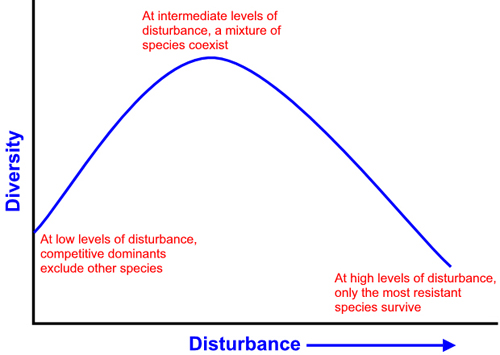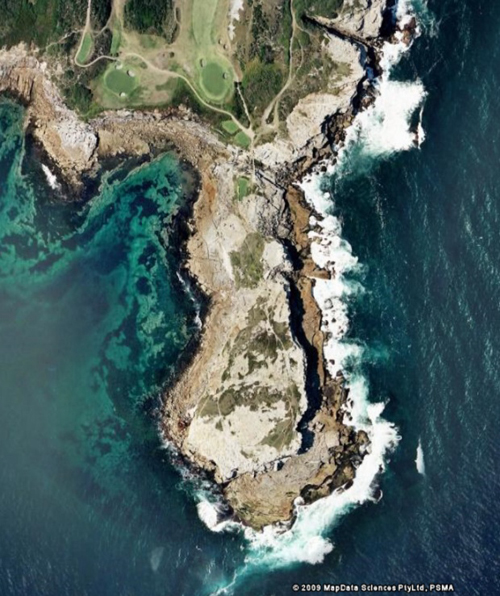Disturbance
2. Community responses to disturbance
In the first part of this particular topic, we looked at features of disturbance in marine environments. The effects of disturbance on individual organisms are clear from the definition given in Module 3:
a "relatively discrete event that causes widespread mortality of the dominant species within an ecosystem".
Disturbance usually kills, or at least severely damages, organisms in the community. In Module 3, Lindsay described how an increase in disturbance – in that case, fire – could cause a shift in the composition of the community from one type of vegetation to another, very different, type.
The effects of changing the frequency, or intensity, of disturbance may, however, be more complex. Probably the most widely cited study of disturbance, and its effects on tropical communities, is a 1978 paper, in the journal Science, by J. H. Connell: "Diversity in tropical rainforests and coral reefs". The summary reads: "The commonly observed high diversity of trees in tropical rain forests and corals on tropical reefs is a nonequilibrium state which, if not disturbed further, will progress toward a low-diversity equilibrium community, This may not happen if gradual changes in climate favor different species. If equilibrium is reached, a lesser degree of diversity may be sustained by niche diversification or by a compensatory mortality that favors inferior competitors. However, tropical forests and reefs are subject to severe disturbances often enough that equilibrium may never be attained."
Note: Connell's paper was cited so frequently that it became a "citation classic" in 1987. Connell's description of how he came to do the work on which the paper was based is a nice example of how reality – in his case, a cyclone – can upset carefully nurtured ideas.
The paper by Connell has been most influential in providing support for the intermediate disturbance hypothesis (IDH).
Wikipedia has a short introduction to this ecological hypothesis (or model) http://en.wikipedia.org/wiki/Intermediate_Disturbance_Hypothesis.
Note: The Wikipedia article says that "hypothesis caused concern among the marine science community because of the discrepancy with the 1976 Competition/Predation/Disturbance model proposed by Menge & Sutherland in American Naturalist". It would be more accurate to say that these were two different models for the processes structuring marine communities; and there were other models and other ideas.
The key ideas in the IDH are: "With low disturbance, competitive exclusion by the dominant species arises. With high disturbance, only species tolerant of the stress can persist." This is illustrated graphically below:

One criticism of the IDH is that there may be no clear definition of what "intermediate disturbance" corresponds to and disturbance may be difficult to quantify. This can make the model difficult to use for predictions. Nonetheless, there are systems in which disturbance can be quantified and it was in one such system – an intertidal boulder field on the coast of California – that one of the first tests, and demonstrations, of the IDH was done.
Sousa (1979) reported that "Boulders with an intermediate probability of being disturbed are most variable in species diversity". Sousa's study, although it did show that the IDH explained patterns in his system, concerned only the algae on boulders in one place. Starting early in the 1980's, Keith McGuinness also studied organisms on boulders, this time in New South Wales. The picture below, courtesy of Google Earth, is one of the sites: Cape Banks, on the northern side of Botany Bay.

In contrast to Sousa, McGuinness (1987) looked at four sites and at both the plants and animals. One of his conclusions was that "disturbance played a similar role in all places – it killed organisms and created free space – but the final effects on the community varied depending upon the species present and the actions of other factors". Read the abstract The tops of intertidal boulders on the east coast of Australia may carry a half-dozen alga, while the under-sides may support a dozen or more species of sessile animals: mobile forms such as molluscs. Crustaceans and ecchinoderms are also common. These organisms are disturbed when boulders are moved by waves or buried in sand. Experiments were done to test the hypothesis thatthese disturbances are responsible for the reduced diversity and abundance of the assemblages on the undersides of small boulders. Boulders on one shore were bolted to the substratum to prevent movement by waves. In two separate experiments on another shore, boulders with and without attached organisms were buried in a few centimetres of sand. All experiments included relevant controls and were done high and low on the shore using rocks of several sizes.
The assemblages of algae developing on the tops of all stabilised boulders. regardless of size, were similar to those on boulders free to roll indicating that, in contrast to results elsewhere, disturbance by waves was too infrequent or slight to affect these species. The tops of rocks were also rarely buried in sand and the main influences on the community in this situation were apparently exposure at low-tide and grazing gastropods.
More species, however, did settle or survive on the undersides of rocks which were free of sand or could not be moved by waves; thus disturbances were important in this situation. In the absence of disturbance low on the shore, much or all space was occupied and sessile species such as sponges and ascidians overgrew other forms and reduced diversity. This did not happen higher on the shore and here diversity was simply an increasing function of rock-size. Overall, disturbance played a similar role in all places - it killed organisms and created free space – but the final effects on the community varied depending upon the species present and the actions of other factors.
More recent work concludes that the IDH may explain what happens in some systems but the model is too simple to account for all cases:
Katriona et al. (2004): "Coexistence mechanisms that require environmental variation to operate contribute importantly to the maintenance of biodiversity. One famous hypothesis of diversity maintenance under disturbance is the intermediate disturbance hypothesis (IDH). The IDH proposes patterns of peaked diversity under intermediate disturbance regimes, based on a tension between competitively superior species and species which can rapidly colonize following disturbance. We review the literature, and describe recent research that suggests that more than one underlying mechanism can generate this unimodal diversity pattern in disturbed environments."
Karin and Andreas (2005): "Succession after disturbances generates a mosaic of patches in different successional stages. The intermediate disturbance hypothesis predicts that intermediate disturbances lead to the highest diversity of these stages on a regional scale resulting in a hump-shaped diversity–disturbance curve. We tested this prediction using field data of forest succession and hypothetical succession scenarios in combination with analytical and simulation models. According to our study the main factors shaping the diversity–disturbance curve and the position of the diversity maximum were the transition times between the successional stages, the transition type, neighbourhood effects and the choice of diversity measure. Although many scenarios confirmed the intermediate disturbance hypothesis we found that deviations in the form of two diversity maximums were possible. Such bimodal diversity–disturbance curves occurred when early and late successional stages were separated by one or more long-lived (compared to the early stages) intermediate successional stages. Although the field data which met these conditions among all those tested were rare (one of six), the consequences of detecting two peaks are fundamental. The impact of disturbances on biodiversity can be complex and deviate from a hump-shaped curve."
Natural and anthropogenic ("unnatural") disturbance
Connell (1978) concluded his paper by writing: "Although tropical rainforests and coral reefs require disturbances to maintain high species diversity, it is important to emphasize that adaptation to these natural disturbances developed over a long evolutionary period. In contrast, some perturbations caused by man are of a qualitatively new sort to which these organisms are not necessarily adapted . In particular, the large-scale removal of tropical forests with consequent soil destruction, or massive pollution by biocides, heavy metals, or oil, are qualitatively new kinds of disturbances, against which organisms usually have not yet evolved defenses. Tropical communities are diverse, thus species populations are usually smaller than those in temperate latitudes, which increases the chances that such new disturbances will cause many species extinctions." (italics added)
Activity
There is no activity for this topic. Please use the time to work on the third assessment item.
References
- Connell, J. (1987). "Diversity in tropical rain forests and coral reefs." Science 199: 1302-1310.
- TÖPKE, Katrien (2021): Coral reefs. Available from http://www.coastalwiki.org/wiki/Coral_reefs
- Wikipedia. (2009) Disturbance. Online at: http://en.wikipedia.org/wiki/Disturbance_(ecology)
- Wikipedia. (2009) Intermediate disturbance hypothesis. Online at: http://en.wikipedia.org/wiki/Intermediate_Disturbance_Hypothesis.